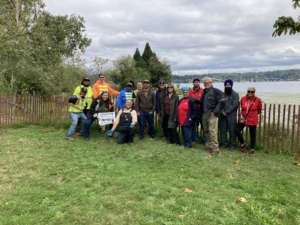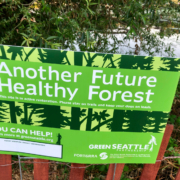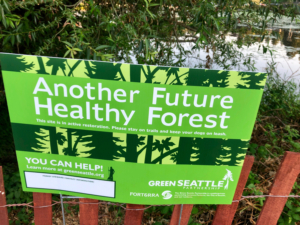
Touring the Lakewood Sanctuary on September 17th, 2024. Participants include the crew from Seattle Parks that stewards the Sanctuary, and folks from Friends of Lakewood Sanctuary, Lakewood Marina, Lakewood Seward Park Neighborhood Association, and Turtle Survival Alliance.
Whoohooo the Lakewood Sanctuary is looking great!
The plants and trees that were installed beginning almost two years ago in January 2023 have been growing, and Seattle Parks’ natural area crews have been weeding, mulching and watering, and planting trees, as part of the restoration effort. The Sanctuary, a small fenced area located between S. Adams St. boat launch and the Lakewood Marina, has been designated by Seattle Parks as a restoration area, and is a natural refuge for flora and fauna.
About 20 folks toured the site Tuesday Sept. 17th to discuss the progress and share ideas, including community members and the crew from Seattle Parks that maintains the site,
Matthew Hilliard, Seattle Parks’ Natural Area Crew Senior Gardener, said that more than 300 hours have been spent improving habitat since the beginning of 2024 . “We’ve made a heavy investment in the restoration,” he said. He added he was gratified to see the hard work paying off in habitat improvement as well as in appreciation from the community and citizen science at the site (notably in turtle surveys and research). Hilliard also said he was pleased with the establishment of a herbaceous understory which provides habitat for a range of small creatures including insects. The sanctuary is “not just beavers and birds, [it’s] awesome for other creatures too.”
Willows are thriving in the Sanctuary as are lady fern, both well adapted to the lakeside environment. Evergreen conifers and fir trees are becoming established, protected from gnawing beavers with metal cages. The area is much changed from a few years ago when it was monster patch of blackberries, but “restoration takes more time than previously appreciated,” Hilliard cautioned.
Jim Pignatelli with Turtle Survival Alliance spoke about the turtle research he is conducting annually. He reported finding a well-hidden red-eared slider turtle nest, but it was not viable. Indeed, red-eared sliders, the predominate turtle in Lake Washington, are not native but apparently unable to reproduce due to the short summer season. For that reason, while non native, the turtles are not considered invasive. They arrive in the lake as pet releases.
Intrusions by humans into the Sanctuary are much reduced, according to Andrew Shroyer, who as manager of the adjacent Lakewood Marina keeps a close watch, but people are still bypassing the fencing or ignoring the do-not-enter sign in the water to paddle their stand-up paddleboards or fish the lily pads from bass boats. More information about the Sanctuary to help educate the general public would be helpful, he said. “People don’t realize how amazing it is.”
Bridget Kelsh, Integrated Pest Management and Wildlife Coordinator (Senior Environmental Analyst) with Seattle Parks, key coordinator for the Sanctuary, said that among other developments Seattle Parks was now specifically monitoring impact of beavers on trees. Around the Sanctuary such impacts include gnawing on the bark of cottonwood trees and plastic water pipes that serve the Marina.
Looking ahead to next spring, a community work party is planned in coordination with Seattle Parks, to provide information about the Sanctuary, mulch and weed, and have a good time!
David Berger,
Friends of Lakewood Sanctuary
Sept. 18, 2024


 david berger 2022
david berger 2022